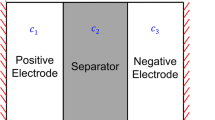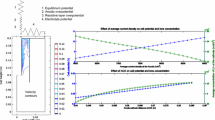Abstract
Energy conversion and storage in a Li-ion cell involves multiple closely coupled transport processes, such as species diffusion through solid and solution phases in the electrode. Mathematical modeling of these processes is critical for fully understanding and optimizing the performance of a Li-ion cell. While a number of analytical and numerical models have been presented for solution phase diffusion, most of such work is based on the assumption of a constant current density. This paper presents analytical modeling of solution phase diffusion in a separate–electrode composite for a generalized, time-dependent current density. An analytical solution for the concentration field in a separator–electrode composite in such conditions is derived using the method of eigenfunction expansion. Good agreement with past work as well as numerical simulations is shown. Results for linear, periodic and step-function boundary conditions are discussed. The theoretical analysis presented here may help accurately model realistic processes where the applied current changes over time, for example, cyclic charge and discharge in an electric vehicle, or sudden changes in the battery load. Results presented here contribute towards the fundamental understanding of solution phase diffusion in Li-ion cells, and provide a basis for improving electrochemical energy conversion and storage processes.
Graphic abstract









Similar content being viewed by others
Abbreviations
- c :
-
Concentration (mol m−3)
- C :
-
Non-dimensional concentration, \(C=\frac{c}{{c}_{0}}\)
- c 0 :
-
Initial concentration (mol m−3)
- D :
-
Diffusivity (m2 s−1)
- F :
-
Faraday constant (C mol−1)
- I :
-
Current density (A/m2)
- J :
-
Non-dimensional generation/consumption term, \(J=-\frac{I(1-{t}^{+}){L}_{1}^{2}}{FD{L}_{2}{c}_{0}\varepsilon }\)
- L :
-
Layer thickness (m)
- r :
-
Ratio of electrode and separator thicknesses, \(r=\frac{{L}_{2}}{{L}_{1}}\)
- t + :
-
Transference number (s)
- t :
-
Time (s)
- x :
-
Spatial coordinate (m)
- ε :
-
Porosity
- λ :
-
Eigenvalue
- τ :
-
Non-dimensional time, \(\tau =\frac{Dt}{{L}_{1}^{2}}\)
- ξ :
-
Non-dimensional spatial coordinate, \(\xi =\frac{x}{{L}_{1}}\)
- 1 :
-
Separator
- 2 :
-
Electrode
References
Goodenough JB, Park K-S (2013) J Am Chem Soc 135:1167–1176
Scrosati B, Garche J (2010) J Power Sources 195:2419–2430
Parhizi M, Ahmed M, Jain A (2017) J Power Sources 370:27–35
Pasquier AD, Plitz I, Menocal S, Amatucci G (2003) J Power Sources 115:171–178
Shah K et al (2017) J Electrochem Energy Convers Storage 14:020801
Gomadam PM, Weidner JW, Dougal RA, White RE (2002) J Power Sources 110:267–284
Xiong R, Cao J, Yu Q, He H, Sun F (2018) IEEE Access 6:1832–1843
Xiao M, Choe S-Y (2012) J Power Sources 218:357–367
Nejad S, Gladwin D, Stone D (2016) J Power Sources 316:183–196
Zhang J, Lee J (2011) J Power Sources 196:6007–6014
Jokar A, Rajabloo B, Désilets M, Lacroix M (2016) J Power Sources 327:44–55
Jardine AK, Lin D, Banjevic D (2006) Mech Syst Signal Process 20:1483–1510
He H, Xiong R, Fan J (2011) Energies 4:582–598
He H, Zhang X, Xiong R, Xu Y, Guo H (2012) Energy 39:310–318
Santhanagopalan S, Guo Q, Ramadass P, White RE (2006) J Power Sources 156:620–628
Subramanian VR, Diwakar VD, Tapriyal D (2005) J Electrochem Soc 152:1–8
Newman J, Tiedemann W (1975) AIChE J 21:25–41
Doyle M, Fuller TF, Newman J (1993) J Electrochem Soc 140:1526–1533
Ramadesigan V et al (2012) J Electrochem Soc 159:31–45
Botte GG, Subramanian VR, White RE (2000) Electrochim Acta 45:2595–2609
Zhang Q, White RE (2007) J Power Sources 165:880–886
Subramanian VR, Ritter JA, White RE (2001) J Electrochem Soc 148:444–449
Cai L, White RE (2009) J Electrochem Soc 156:A154–A161
Luo W, Lyu C, Wang L, Zhang L (2013) J Power Sources 241:295–310
Fuller TF, Doyle M, Newman J (1994) J Electrochem Soc 141:1–10
Subramanian VR, Tapriyal D, White RE (2004) Electrochem Solid-State Lett 7:A259–A263
Ramadesigan V, Boovaragavan V, Pirkle JC, Subramanian VR (2010) J Electrochem Soc 157:A854–A867
Subramanian VR, Boovaragavan V, Ramadesigan V, Arabandi M (2009) J Electrochem Soc 156:A260–A271
Northrop PWC, Ramadesigan V, De S, Subramanian VR (2011) J Electrochem Soc 158:A1461–A1477
Ning G, Popov BN (2004) J Electrochem Soc 151:A1584–A1591
Rahimian SK, Rayman S, White RE (2013) J Power Sources 224:180–194
Doyle M, Newman J (1997) J Appl Electrochem 27:846–856
Subramanian VR, White RE (2001) J Power Sources 96:385–395
Atlung S (1979) J Electrochem Soc 126:1311–1321
Ali SH, Hussin A, Arof A (2002) J Power Sources 112:435–442
Johan MR, Arof AK (2004) Ionics 10:405–414
Liu S (2006) Solid State Ionics 177:53–58
Johan MR, Arof AK (2007) J Power Sources 170:490–494
Parhizi M, Jain A (2020) J Electrochem Soc 167:120544
Guo M, White RE (2012) J Power Sources 198:322–328
Verma S, Khosla A, Arya S (2020) J Electrochem Soc 167:120527
Newman J, Thomas-Alyea KE (2004) Electrochemical systems. Wiley, Hoboken
Wu X, Shi J-Y, Lei H, Li Y-P, Okine L (2019) J Central South Univ 26:3175–3187
Acknowledgements
This material is based upon work supported by CAREER Award No. CBET-1554183 from the National Science Foundation. This research was also supported by the Key Project of Science of the Education Bureau of Henan Province (Grant No. 19B460005), Special Project of Basic Scientific Research Operating Expenses of Henan Polytechnic University (Grant No. NSFRF180427), and China Scholarship Council.
Author information
Authors and Affiliations
Corresponding author
Additional information
Publisher's Note
Springer Nature remains neutral with regard to jurisdictional claims in published maps and institutional affiliations.
Appendix A: Dimensional equations and non-dimensionalization scheme
Appendix A: Dimensional equations and non-dimensionalization scheme
Based on the assumptions listed in Sect. 2, the concentration conservation equations for separator and electrode layers may be written in dimensional form as follows:
and
Note that the migration term is zero based on the common assumption of constant transference number [42]. The term \( - \frac{{I\left( t \right)\left( {1 - t_{ + } } \right)}}{{F \cdot L_{c} }} \) appearing in Eq. (38) represents the pore wall flux, assumed to be uniform and constant [42]. The dimensional boundary conditions are
The initial condition is
The non-dimensional variables are defined as follows
Substituting in Eqs. (37)–(38), one may obtain the following non-dimensional governing equations:
where
Similarly, substituting in the boundary conditions, given by Eqs. (39)–(42), one may obtain
where r = L2/L1. The initial condition in non-dimensional form is
Equations (45)–(52) constitute the set of non-dimensional equations solved in this work (Eqs. (1)–(4)).
Rights and permissions
About this article
Cite this article
Zhou, L., Parhizi, M. & Jain, A. Theoretical analysis of transient solution phase concentration field in a porous composite electrode with time-dependent flux boundary condition. J Appl Electrochem 51, 1241–1252 (2021). https://doi.org/10.1007/s10800-021-01573-x
Received:
Accepted:
Published:
Issue Date:
DOI: https://doi.org/10.1007/s10800-021-01573-x




